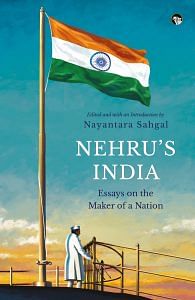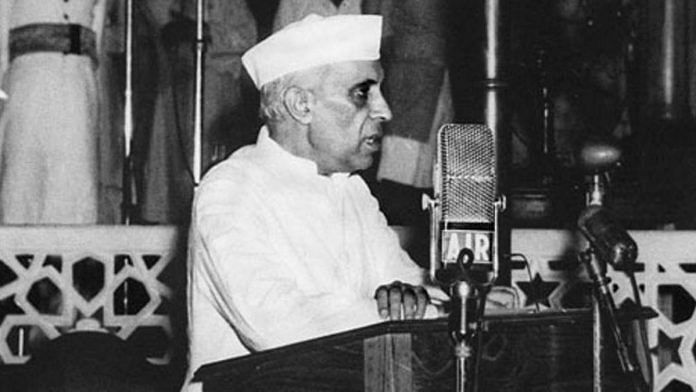The conventional understanding of Nehru as indifferent to religion is not untrue. But it is not wholly true either. There were times in his life when he was deeply drawn to religious texts and ideas. One such period was when he was in jail in 1921-22, during the Non-cooperation Movement. I recently found two remarkable letters written by Nehru to Gandhi in the early months of 1922. These letters do not appear in the Selected Works of Jawaharlal Nehru, nor have they been quoted by Nehru biographers. These letters may have been overlooked by scholars because they rest not in the Nehru papers in New Delhi but in the Gandhi papers in Ahmedabad.
Yet the letters are important, not least because they complicate the received understanding of Nehru’s approach to religion. Both these letters to Gandhi are handwritten; both were sent from the same address, the District Jail in Agra. The first letter is dated 9 January 1922. Here, Nehru mentions what he has been reading in prison— namely, mostly religious books. Thus he writes: ‘I have read Glover’s Jesus of History—a book of absorbing interest, and have also done a good deal of the Bible in the light thereof. I have begun seriously reading the Ramayan—Tulsi too, and Kabir’s bhajans and slokas from Bhagavad Gita serve as memory exercises whilst I have my morning and evening walks. I have, as you might well imagine, regularly done my prayers, regularly retired at the time appointed by you, and been out of bed at the same hour when, as Nanak says the “Heavens rain nectar”.’ Later in the same letter, Nehru remarks: ‘My days are passed among the saints nowadays, and I should love to finish as well as I can my knowledge of the Bible, the Saints (including Christian Saints of course), the Ramayan and the Mahabharat (including of course the Bhagavad Gita). I have some secular literature [with me], no doubt, but that takes frankly, a subordinate place. The memorizing of songs and verses is a grand thing—it puts me in mind of the great times when our men and women lived and moved as men and women and carried the treasures of all their religious and philosophical lore in the impregnable fortresses of their memories.’
The second letter was written four weeks later, on 19 February 1922. Nehru had recently been joined in prison by one ‘Khwaja Saheb’ from Aligarh. ‘It is a privilege to learn Urdu from Khwaja,’ writes Nehru to Gandhi. ‘It is such a stately script, almost symbolic of the easy splendours of the Mussalman.’ Apart from teaching Nehru the Urdu script, Khwaja gave him ‘a few couplets from Urdu poets every day, and important verses from the Koran. I in my turn give Khwaja something from the Upanishads and propose to give him something from the Gita’. Meanwhile, with another fellow prisoner, one Ram Nareshji, Nehru had finished the sections of the Ramayana named ‘Balakand’ and ‘Ayodhyakand’. ‘I hope to finish the rest in about twenty days,’ wrote Nehru to Gandhi, ‘as I finished “Sundarakand” in Naini [jail] and the rest is plain sailing. It is a joy to read [the] Ramayan every morning. When a quiet early hour of the night is selected for reading it, one almost melts in the liquid love of Tulsi. Ramayan is more a spiritual autobiography than a poetic history of Rama’.
There is a poetic quality to Nehru’s own descriptions too. Clearly, he was loving his time with sacred literature. At this time in his life, secular works were taking a ‘subordinate place’ to texts written (and sung) at a time when Indian men and women ‘carried the treasures of all their religious and philosophical lore’. When these letters were written, Nehru was in his early thirties. He had lately fallen under the spell of Gandhi, whose own faith was both religious as well as eclectic, drawing from several different sources. The three religious thinkers Gandhi most often invoked were the Vaishnava poet Narsinh Mehta, the Jain philosopher Raychandbhai, and the heterodox Christian Leo Tolstoy.
Also read: ‘Expansionist’ Nehru, Tibetan autonomy, ‘New China’ — why Mao went to war with India in 1962
It may have been the Mahatma’s influence that made the young Nehru, in jail, soak himself in the texts and traditions of Hinduism, Islam, Christianity and Sikhism. However, within a decade of writing these letters to Gandhi, Nehru seems to have left behind his enchantment with religion. Why? During the Noncooperation movement Hindus and Muslims worked shoulder to shoulder. But later in the decade the communities began to drift apart, and there were a series of Hindu-Muslim riots in Northern India. Perhaps Nehru now believed that religion was a dangerous and divisive force in Indian politics, and had best be kept out of the discussion. In the 1930s, Nehru also became influenced by Western socialism. This prided itself on its secular, scientific ethos, and was implacably opposed to expressions of religious faith. While in jail in 1921-22 Nehru had little time for secular literature—now, that was all he was reading.
The Partition riots of 1947 furthered Nehru’s distaste for organized religion. The malign activities of the Muslim League on the one side and of hardline Hindu groups such as the Rashtriya Swayamsevak Sangh on the other, convinced him that sectarian identities were a danger to the unity of India. As he put it in a letter to his chief ministers in December 1952, the nation must not be allowed to ‘go astray in the crooked paths of provincialism, communalism, casteism and all other disruptive and disintegrating tendencies’. The Nehru of the 1940s and 1950s wished to promote a ‘scientific temper’ among the Indian masses. Religion, he felt, had absolutely no place in the process of nation-building. India must never become a ‘Hindu Pakistan’. However, as he grew older, Nehru began to see that while it must be kept far away from politics, religious faith could still play a role in an individual’s quest for truth and tranquillity.
 This excerpt from Nayantara Sahgal’s ‘Nehru’s India’ has been published with permission from Speaking Tiger.
This excerpt from Nayantara Sahgal’s ‘Nehru’s India’ has been published with permission from Speaking Tiger.



